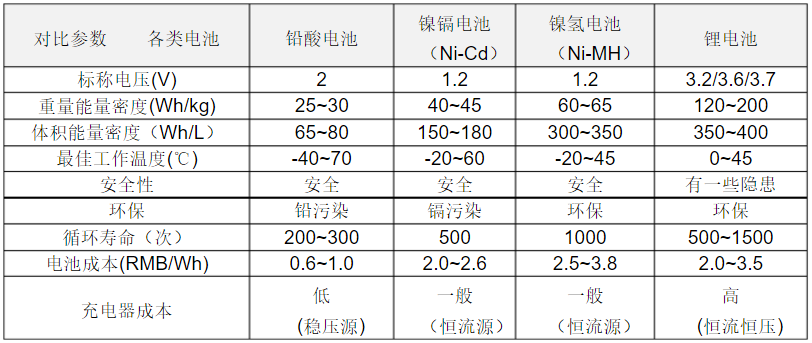(1) The composition of lithium batteries
The lithium battery is mainly composed of two blocks, the battery cell and the protection board PCM (power battery-generally called the battery management system BMS). The battery cell is equivalent to the heart of the lithium battery, and the management system is equivalent to the brain of the lithium battery. The battery core is mainly composed of positive electrode material, negative electrode material, electrolyte, diaphragm and shell, while the protection board is mainly composed of protection chip (or management chip), MOS tube, resistor, capacitor and PCB board.

(2) Advantages and disadvantages of lithium batteries
Lithium batteries have many advantages, high voltage platform, high energy density (light weight, small size), long service life, and environmental protection.
The disadvantages of lithium batteries are relatively high price, relatively narrow temperature range, and certain potential safety hazards (protection system is required).
(3) Lithium battery classification
Lithium batteries can be divided into two categories: disposable non-rechargeable batteries and secondary rechargeable batteries (also known as batteries).
Non-rechargeable batteries such as lithium manganese dioxide batteries, lithium-thionamide batteries.
Secondary rechargeable batteries can be divided into the following classifications according to different situations.
1.According to the appearance: square lithium battery (such as ordinary mobile phone battery) and cylindrical lithium battery (such as 18650 for power tools);
2. According to outsourcing materials: aluminum shell lithium battery, steel shell lithium battery, soft pack battery;
3.According to the cathode material: lithium cobalt oxide (LiCoQ), lithium manganate (LiMn204, ternary lithium (LiNi, Co, Mn202), lithium iron phosphate (LiFeP0);
4. According to electrolyte status: lithium ion battery (LIB) and polymer battery (PLB);
5. According to the purpose: ordinary battery and power battery.
6. According to performance characteristics: high-capacity battery, high-rate battery, high-temperature battery, low-temperature battery, etc.
(4) Explanation of commonly used terms
1.
Capacity (Capacity)
Refers to the amount of electricity that can be obtained from battery lithium under certain discharge conditions. As we know in high school physics, the formula for power is Q=I*t, the unit is coulomb, and the unit of battery capacity is specified as Ah. (Ampere hour) or mAh (Mailliamp hour). This means that a 1AH battery can be discharged for 1 hour with a current of 1A when fully charged. The battery of the old NOKIA mobile phone (like BL-5C) is generally 500mAh, the current smart phone battery is 800~1900mAh, the electric bicycle is generally 10 to 20Ah, the electric car is generally 20 to 200Ah, etc. .
2.
The charge-discharge rate (Charge-Rate/Di scharge-Rat day, indicates how much current is used to charge and discharge,-. Generally, it is calculated as a multiple of the battery's nominal capacity, generally called a few C. Like a battery with a capacity of 1500mAh, it is specified 1C=1500mAh, if it is discharged at 2C, it will be discharged at a current of 3000mA.
0.1C charge and discharge is to charge and discharge with a current of 150mA.
3.
Voltage (0CV: Open Circuit Voltage
The battery voltage generally refers to the nominal voltage (also called the rated voltage) of the lithium battery. The nominal voltage of an ordinary lithium battery is generally 3.7V, and we also call its voltage platform 3.7V. The voltage we are talking about generally refers to the open circuit voltage of the battery. When the battery capacity is 20^80%, the voltage is concentrated around 3.7V (about 3.6 ~ 3.9V), the capacity is too high or too low, and the voltage changes greatly.
4.
Energy/Power
The battery discharges according to a certain standard, the energy (E) that the battery can release, the unit is Wh (watt hour) or KWh (kilowatt hour), and 1KWh=1 kilowatt hour. There is a basic concept in the physics book, E=U*I*t, which is also equal to the battery voltage multiplied by the battery capacity. The formula for power is P=U*I=E/t, which represents the energy that can be released per unit time. The unit is W (watt) or KW (kilowatt). In addition, 1KWh=1 kWh. There is a basic concept in the physics book, E=U*I*t, which is also equal to the battery voltage multiplied by the battery capacity. The formula for power is P=U*I=E/t, which represents the energy that can be released per unit time. The unit is W (watt) or KW (kilowatt). Like a battery with a capacity of 1500mAh, the nominal voltage is generally 3.7V, so the corresponding energy is 5.55Wh.
5.
Internal resistance (Resi stance)
Because it cannot be equivalent to an ideal power source during charging and discharging, it has a certain internal resistance. Internal resistance consumes energy, of course, the smaller the internal resistance, the better. The unit of battery internal resistance is milliohm (mQ). Generally, the internal resistance of a battery is composed of ohmic internal resistance and polarized internal resistance. The size of the internal resistance depends on the material, manufacturing process, and electrical
The influence of the structure of the pool.
6.
Cycle Life (Cycle Life)
The charge and discharge of a battery is called a cycle, and the cycle life is an important indicator of battery life performance.





